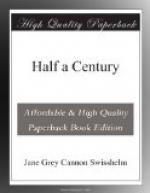My Catholic patrons gradually withdrew their advertisements and subscriptions. Thousands of Protestants were rejoiced at what they called my triumph, and borrowed the Visiter to read my articles. Very many bought copies, but I think I did not gain one subscriber or advertiser by that labor in defense of a common cause. Nay, I lost Protestant as well as Catholic support, for business men did not care to be known to Catholic customers as a patron of a paper which had strenuously opposed the policy of the church. That experience and a close observation for many years have taught me that the secular papers of the United States, with a few exceptions, are almost as much under the control of the Pontiff as the press of Austria. Nor is it the secular press alone which is thus controlled. There are religions papers who throw “sops to Cerebus,” as an offset to teachings demanded by Protestant readers. These “sops” are paid for indirectly by patronage, which would be withdrawn whenever the Bishop took alarm at an article in that same paper.
Protestants do not carry their religion either into political or business relations, and so there is no offset to the religious, political and business concentration of Romanism.
There was no other outbreak between me and my Catholic neighbors until the dedication of the Pittsburg cathedral, when my report gave serious offense, and caused Bishop O’Conner to make a very bitter personal attack on me. He did not know how truly the offensive features of my report were the result of ignorance; but thought me irreverent, blasphemous. I had never before been inside a Catholic church; never seen a Catholic ceremonial; did not know the name of a single vestment; was overwhelmed with astonishment, and thought my readers as ignorant as I; so tried to give a description which would enable them to see what I had seen, hear what I had heard.
Every bishop and priest and member of any religions brotherhood in this country and Canada was said to be present. Some of the things they wore looked like long night-gowns, some short ones; some like cradle quilts, some like larger quilts. There were many kinds of patch-work and embroidery; some of the men wore skirts and looked very funny. Quite a number wore something on their heads which looked like three pieces of pasteboard, the shape of a large flat-iron, and fastened together at the right angles and points. They formed into procession and started around the outside of the building. I thought of going “around and about” Jerusalem, and the movement had a meaning; but they walked into a fence corner, swung a censor, turned and walked into another corner, and then back into the house, without compassing the building. I said there was nothing to prevent bad spirits coming in at that side.
I copied the Bishop’s angry reply, plead my ignorance and that of Protestants in general for all that seemed irreverent, and called upon him for explanations. What did it all mean? What was the spiritual significance of those externals? I ignored his evident anger; had no reason to be other than personally respectful to him, yet my second article irritated him more than the first.




